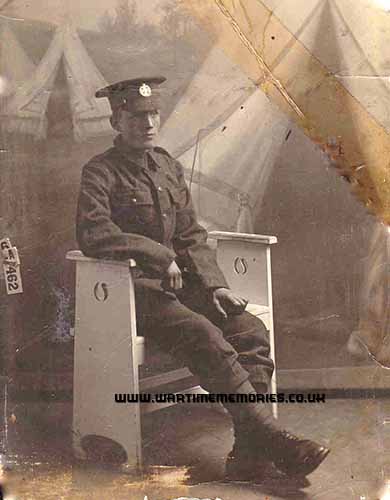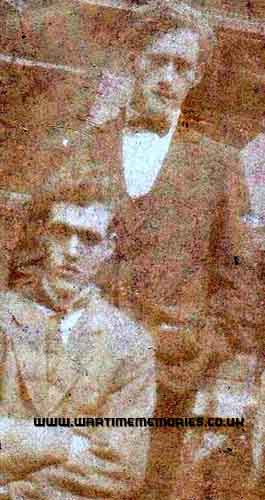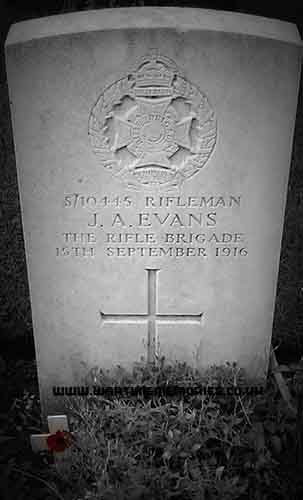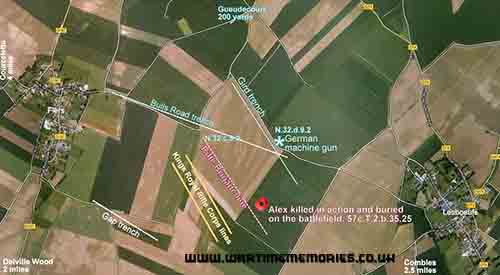Additions will be checked before being published on the website and where possible will be forwarded to the person who submitted the original entries. Your contact details will not be forwarded, but they can send a reply via this messaging system.
please scroll down to send a message
Rflmn. John Alexander Evans
British Army 9th Battalion Rifle Brigade
from:Plaistow, Greater London
(d.15th Sep1916)
Alex Evans was born on 3rd October 1896, a twin and one of 12 children. On 5th May 1915 he enlisted for the Rifle Brigade at St Paul's church yard and was initially with 6th battalion. He was shipped to France on October 7th 1915 with the 9th battalion Rifle Brigade. On 18th May 1916 he was wounded in action by a gunshot to the thigh and was in hospital in Rouen and transferred to Étaples on 14th June 1916, Two days later on 16th June he rejoined his battalion on the Somme.
On 14th September the battalion marched overnight from Bécordel-Bécourt to Delville Wood in readiness for the commencement of the battle of Flers-Coucelette. The battalion war diary for 16th September is sadly thin with no details but the 9th battalion Kings Royal Rifle Corps diary was well kept by their officer. The extracts from the KRRC diary tells the story and fate of Alex's battalion, the 9th battalion Rifle Brigade, who led the attack on Gird Trench and Bulls Road during the first day of the battle of Flers-Courcelette (15th-22nd September 1916) on the Somme, France. The KRRC were to the rear of the Rifle Brigade.
Extracts:
6.20am. Btn moved from Montauban Alley to York Alley behind 9th btn RB.
8am. The 9th btn RB appeared to be bearing away too far to their right and were only in front of the right half of A company.
8.15am. Btn passed through Switch Trench without stopping. Machine gun fire from Lesboeufs area passing over their heads (Lesboeufs being the village to their right on Bulls Road being attacked by the Guards division - the 9th btn RB will have gone through just before them.)
8.30am -8.45am. The btn continued to advance without stopping and passed through Gap Trench on the heels of 9th btn RB still bearing off to their right.
9am. Two German field guns firing towards Flers (the village to their left on Bulls Road) from a position on Sunken Road near N.32.c.5.2.
Meanwhile 9th btn RB had stopped advancing and had formed a line more or less parallel with Gird Trench, their left being N.32.c.9.0.
About 9.30am. I asked Capt Merewether, then commanding 9th btn RB, what were his intentions. He told me 9th Btn RB intended to attack Gird Trench at the appointed time according to the programme. Seeing as his battalion were very weak I told him that the 9th btn KRRC would advance in close support of the 9th btn RB.
9.30am. The battalion was organised in two lines behind the 9th btn RB ready to advance behind them. Btn HQ established at T.2.c.3.7 from where a good view of the front could be obtained.
9.30am – 11.20am. Our (artillery) guns did not appear to be shelling Gird Trench (meaning the German machine guns and snipers in the trench were not impeded at all). Although no friendly shelling on Gird Trench the 9th btn RB tried to advance on this trench but as soon as they got on the rising ground in front of them a hostile machine gun situated at about N.32.d.9.2 prevented them advancing. All their remaining officers (approx 16 including Capt. Merewether) were killed bar one junior officer and 315 other ranks, (including Alex), and their attack failed. Seeing this I assumed command of the remainder of the 9th btn RB.
The officer of the KRRC decided it was too dangerous to continue at that time but their objectives were met later that day.
Also in the diary was a reference to the tanks, "A new engine of war, a petrol- driven armoured car, termed the tank was used for the first time. Four of these machines were allotted to the division during these operations and are considered to have done splendid work." The tank. D5 Dolphin was in the area with Alex's battalion providing support. Dolphin managed to cover more ground that day than any other tank (more than 4000 yards).
Alex was buried initially on the battlefield at 57c.T.2.b.35.25 before eventually being move to Combles Communal Cemetery Extension about 3 miles away. He was 19 years old. His twin brother Charlie survived the war and lived until the age of 75.




